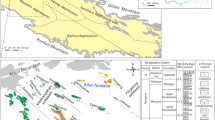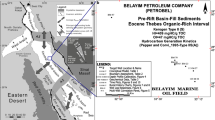Abstract
Based on the geochemical characteristics of oil-cracking gas and kerogen-cracking gas revealed by simulation experiments and the chemical composition of natural gases in actual gas reservoirs, two kinds of natural gases with different relationships between C2/C3 and C1/C2, C2/C3 and C1/C3, C2/C3 and 100×C1/(C1–C5) were identified in the Tarim Basin, and proposed further by the authors. The relationship charts of C2/C3 and C1/C2, C2/C3 and C1/C3, C2/C3 and 100×C1/(C1–C5) can be used to effectively distinguish oil-cracking gas from kerogen-cracking gas. Petroleum geological analysis of the oil-cracking gas reservoirs showed that the distribution of oil-cracking gas is mostly related with deep-seated faults or faults with a large fault throw, and the burial depth of paleo-oil reservoir is relatively high; crude oil-cracking gas resources have been evaluated by using both forward and inversion methods. The plots of C2/C3 vs. C1/C2, C2/C3 vs. C1/C3, and C2/C3 vs. 100×C1/(C1–C5) were used to distinguish between oil-cracking gas and kerogen-cracking gas, and estimate the mixed ratios of the two kinds of natural gases in the main gas reservoirs of the platform area.
Similar content being viewed by others
References
Bjoroy M., Williams J.A., Dolcater D.L. et al. (1988) Variation in hydrocarbon distribution in artificially matured oils [J]. Org. Geochem. 13(4–6), 901–913.
Chen Shijia, Fu Xiaowen, Ma Lining, Chen Xinling, and Zhang Xiang (2002) Genetic identification method of kerogen cracked gases and oil cracked gases [J]. Petroleum Geology and Experiment. 24, 364–371.
Gao Shengjun, Chen Yicai, Li Yanjun, Wang Bo, Yin Changhe, Li Wentao, and Yang Xianchen (2009) Pyrolysis on crude oil and characteristics of Sha 4 Member cracking gas, Dongying depression [J]. Natural Gas Geoscience. 20, 32–35.
Fang Hao, Tonglou Guo, Yangming Zhu et al. (2008) Evidence for multiple stages of oil cracking and thermochemical sulfate reduction in the Puguang gas field, Sichuan Basin, China [J]. AAPG Bull. 92, 611–637.
Hill R.J., Yongchun Tang, and Isaac R. Kaplan (2003) Insights into oil cracking based on laboratory experiments [J]. Org. Geochem. 34, 1651–1672.
Hu Guoyi, Xiao Zhongyao, Luo Xia, Li Zhisheng, Li Jian, Sun Qingwu, and Wang Chuni (2005) Light hydrocarbon composition difference between two kinds of cracked gases and its application [J]. Natural Gas Industry. 25, 23–25.
Huang Guanghui, Zhang Min, Hu Guoyi et al. (2008) A geochemical study on oil cracking gas and kerogen cracking gas: Part II: Distinguishing method for oil cracking gas and kerogen cracking gas [J]. Science in China (Series D, Earth Sciences). 38(II), 9–16.
Pepper A.S. and Dodd T.A. (1995) Simple kinetic models of petroleum formation. Part II: Oil-gas cracking [J]. Mar. Petrol. Geol. 12, 321–340.
Pinzhofer A. and Huc A.Y. (1995) Genetic and post genetic molecular and isotopic fractionations in natural gas [J]. Chem Geol. 126, 281–290.
Shen Ping and Xu Yongchang (1991) The isotopic composition of natural gases from continental sediments in China [J]. Geochimica. 20, 144–152 (in Chinese with English abstract).
Tan Hui, Xiao Xianming, Yang Guoli et al. (2009) Pyrolysis of oil at high temperature: Gas potentials chemical and carbon isotopic signatures [J]. Chinese Sci. Bull. 54, 781–786.
Wang Hanyun and Yang Tianyu (1982) Simulation experiment for crude oil cracking into gas [J]. Natural Gas Industry. (3), 28–32 (in Chinese).
Wang Zhenping, Fu Xiaotai, Lu Shuangfang et al. (2001) An analogue experiment of gas generating by crude oil cracking, characteristics of products and its significance [J]. Natural Gas Industry. 21, 12–15 (in Chinese).
Zhang Min (2006) Reservoir geochemistry of the Tazhong oilfield in the Tarim Basin, China, Part I. Geochemistry characteristics and genetic classification of crude oils [J]. Chinese Journal of Geochemistry. 25, 328–332
Zhang Min (2007) Reservoir geochemistry of the Tazhong oilfield in the Tarim Basin, China, Part II. Migration, accumulation and mixing of crude oils [J]. Chinese Journal of Geochemistry. 26, 157–162
Zhang Min, Huang Guanghui, Hu Guoyi, and Zhao Hongjing (2008) A geochemical study on oil cracking gas and kerogen cracking gas: Part I: Experimental simulation and products analysis [J]. Science in China (Series D, Earth Sciences). 38(II), 1–8.
Zhao Mengjun and Lu Shuangfang (2000) Natural gas from secondary cracking of crude oil-An important pattern of gas generation [J]. Geological Review. 46, 645–650 (in Chinese).
Zhao Mengjun, Zeng Fanggang, and Qin Shengfei (2001) Two pyrolysis gases found and proved in Tarim Basin [J]. Natural Gas Industry. 21, 35–38 (in Chinese).
Zhao Mengjun, Zhang Shuichang, Liao Zhiqin et al. (2001) The cracking gas from crude oil and its significance in gas exploration [J]. Petroleum Exploration and Development. 28(44), 47–56.
Author information
Authors and Affiliations
Corresponding author
Rights and permissions
About this article
Cite this article
Zhang, M., Chen, X. & Huang, G. Geochemical characteristics, forming conditions and resource evaluation of oil-cracking gas as exemplified by the platform area of the Tarim Basin. Chin. J. Geochem. 30, 346–352 (2011). https://doi.org/10.1007/s11631-011-0518-2
Received:
Accepted:
Published:
Issue Date:
DOI: https://doi.org/10.1007/s11631-011-0518-2




